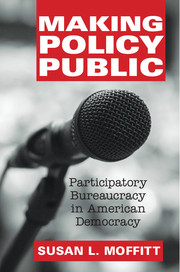Book contents
- Frontmatter
- Dedication
- Contents
- List of Figures
- List of Tables
- Preface
- Abbreviations
- 1 Portals of Democracy in American Bureaucracy
- 2 Participatory Bureaucracy in Practice
- 3 The Development of Public Committees
- 4 Making Educational Performance Public
- 5 Private Knowledge for Public Problems
- 6 Setting the Public Agenda
- 7 Deliberate Participation
- 8 The Impact of Public Advice
- 9 Participatory Bureaucracy in American Democracy
- Appendix
- Bibliography
- Index
- References
2 - Participatory Bureaucracy in Practice
Published online by Cambridge University Press: 05 October 2014
- Frontmatter
- Dedication
- Contents
- List of Figures
- List of Tables
- Preface
- Abbreviations
- 1 Portals of Democracy in American Bureaucracy
- 2 Participatory Bureaucracy in Practice
- 3 The Development of Public Committees
- 4 Making Educational Performance Public
- 5 Private Knowledge for Public Problems
- 6 Setting the Public Agenda
- 7 Deliberate Participation
- 8 The Impact of Public Advice
- 9 Participatory Bureaucracy in American Democracy
- Appendix
- Bibliography
- Index
- References
Summary
Bureaucratic administration means fundamentally the exercise of control on the basis of knowledge ... technical knowledge ... [and] official secrets.
– Max WeberNothing has been discovered which acts in entire isolation.
– John DeweyParticipatory bureaucracy is a systematic process of public engagement that brings diverse expertise to bear on task implementations. When participation is bureaucratic, it is consistent with the core elements of bureaucratic reputation: unique agency expertise and diverse support. When bureaucracy is participatory, the scope of participation is fluid. It enables information to flow in multiple directions – to the agency, from the agency, and beyond the individuals who participate in a particular decision.
Yet, when is participatory bureaucracy likely to arise and add value to bureaucratic administration and democratic accountability? When are we more likely to see participatory oversight that is imposed on bureaucratic administration and that potentially perpetuates the bureaucracy-democracy trade-off, where participation comes at the expense of bureaucratic administration and reputation? The answer resides, in part, in the conditions of the policy task and the design of participation. Scholars have long examined bureaucrats’ intentional and active engagement with publics outside agency walls to build supportive coalitions, to gather information, and to facilitate policy implementation. Agencies also intentionally reveal their information to exert regulatory authority, to persuade, to educate other implementers, and to build consensus. Francis Rourke astutely observed more than a half century ago: “Many ... agencies spend a great deal more time in publicizing themselves than they do in concealing information ... their path to power is publicity rather than secrecy.” Participatory bureaucracy builds on these insights but embodies a key distinction: it has the potential to manage the tension between bureaucratic administration and democratic accountability. In other words, for participation to be bureaucratic, it must support competent public administration. For bureaucracy to be participatory, it must support aspects of democratic accountability. Not all public engagement supports bureaucratic administration. Not all public engagement supports democratic accountability. Participatory bureaucracy represents a subset of public engagement in which both bureaucracy and democracy have the potential to be better off.
- Type
- Chapter
- Information
- Making Policy PublicParticipatory Bureaucracy in American Democracy, pp. 28 - 54Publisher: Cambridge University PressPrint publication year: 2014



